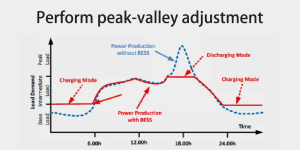Charging an LFP Battery

Lithium-ion batteries may be charged with ease by the majority of conventional solar charge controllers. Similar voltages to those found in AGM batteries are required. The BMS also aids in ensuring that the battery cells receive the proper voltage, are not overcharged or over-discharged, are balanced, and maintain a reasonable cell temperature while they are being charged.

Charge Characteristics
The graph below depicts a typical LiFePO4 battery charging profile. To make things simpler to understand, the voltages have been changed to correspond to what a 12.8 Volt LFP battery pack would observe.
The graph shows a charge rate of 0.5C, or half the Ah capacity, which translates to a charge rate of 50 Amp for a 100Ah battery. Higher or lower charge rates won’t make much of a difference in the charge Voltage because LFP batteries have a fairly flat Voltage curve.
Lithium-ion batteries are charged in two stages: This typically means that in order to maintain a constant current using solar PV, we work to deliver as much current into the batteries as the sun can provide. During this period, the voltage will gradually increase until it hits the “absorb” voltage, shown as 14.6V in the graph above. The battery is around 90% full until absorb is reached; to fill it the remaining 10%, the voltage is maintained while the current gradually decreases. The battery is at 100% State-Of-Charge whenever the current falls to between 5% and 10% of the Ah rating.
There are several reasons why a lithium-ion battery is easier to charge than a lead-acid battery: As long as the charge voltage is enough to move ions, it charges. Lithium-ion batteries don’t mind if they aren’t fully charged because it extends their lifespan. The battery can’t really be overcharged, there’s no real need for equalization or absorption time, and the BMS takes care of keeping everything within acceptable bounds.
Required Charge Voltage
What Voltage will therefore move those ions? A little testing reveals that the cut-off voltage is 13.6 Volt (3.4V per cell), below which very nothing occurs and above which, given enough time, the battery will reach at least 95% capacity. The charging process is generally similar at 14.0 Volts and above; with 14.2 Volts and above, things just move a little more quickly. The battery quickly charges up to 95+ percent at 14.0 Volt (3.5V per cell) with a few hours of soak time.
Volume/Absorb Voltage
In conclusion, LiFePO4 will perform admirably at a bulk/absorb setting between 14.2 and 14.6 Volt! With the aid of some absorption time, lower is also attainable, down to roughly 14.0 Volt. The BMS for the majority of batteries will only permit 14.8 to 15.0 Volts before disconnecting the battery, while slightly higher Voltages are feasible. However, a higher Voltage has no advantages and increases the chance of being cut off by the BMS and potential harm.
Voltage Float
The flotation of LFP batteries is not necessary. Because lead-acid batteries self-discharge at such a high pace, charge controllers contain this feature to keep the batteries from overheating. Lithium-ion batteries shouldn’t continuously have a high State-Of-Charge, thus if your charge controller can’t stop float, just adjust it to a low enough Voltage to stop actual charging. A voltage of 13.6 volts or less is required.
Voltage Equivalence
It should be obvious that a lithium-ion battery shouldn’t be equalized since charge voltages beyond 14.6 Volt are deliberately discouraged! Set equalization to 14.6V or less if it cannot be disabled so that it simply performs a standard absorption charge cycle.
Consume Time
There are several benefits to simply stopping the charging process once the battery reaches 14.4V or 14.6V by setting the absorb Voltage to that value! Briefly, there is no (or little) absorb time. Your battery will be about 90% full at that moment. This strategy will increase battery life because LiFePO4 batteries will last longer if they are not left at 100% SOC for an extended period of time. If your battery needs to be 100% SOC, absorb will make it happen. According to official guidelines, this is attained when the charge current falls below 5% to 10% of the battery’s Ah rating, or 5 to 10 Amp for a 100Ah battery. Set the absorb time to roughly 2 hours and call it a day if you are unable to stop absorbing based on the current.
Temperature Adjustment
Temperature correction is not required for LiFePO4 batteries! In order to prevent your charge voltage from being drastically off in extreme heat or cold, please turn this off in your charge controller.
Make sure to compare the voltage settings on your charge controller to those that were actually measured using a reliable digital multimeter! When charging a lithium-ion battery, even minor voltage variations can have a significant effect! Adjust the charging settings appropriately!











